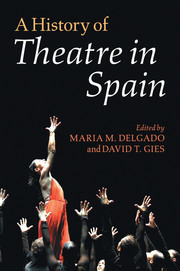Book contents
- Frontmatter
- Contents
- Illustrations
- Contributors
- Acknowledgements
- Introduction
- 1 The challenges of historiography
- 2 Lope de Vega, Calderón de la Barca and Tirso de Molina
- 3 The world as a stage
- 4 Playing the palace
- 5 The art of the actor, 1565–1833
- 6 Theatrical infrastructures, dramatic production and performance, 1700–1759
- 7 Popular theatre and the Spanish stage, 1737–1798
- 8 Theatre of the elites, neoclassicism and the Enlightenment, 1750–1808
- 9 Actors and agency in the modern era, 1801–2010
- 10 Zarzuela
- 11 Nineteenth-century Spanish theatre
- 12 Copyright, buildings, spaces and the nineteenth-century stage
- 13 Modernism and the avant-garde in fin-de-siècle Barcelona and Madrid
- 14 Continuity and innovation in Spanish theatre, 1900–1936
- 15 Theatrical activities during the Spanish Civil War, 1936–1939
- 16 Theatre, colonialism, exile and the Americas
- 17 Theatre under Franco (1939–1975)
- 18 Flamenco
- 19 Nationalism, identity and the theatre across the Spanish state in the democratic era, 1975–2010
- 20 Directors and the Spanish stage, 1823–2010
- 21 This evolution is still ongoing
- 22 Theatre as a process of discovery
- 23 Theatre is the art of the future
- Select bibliography
- Index
- References
4 - Playing the palace
Space, place and performance in early modern Spain
Published online by Cambridge University Press: 05 June 2012
- Frontmatter
- Contents
- Illustrations
- Contributors
- Acknowledgements
- Introduction
- 1 The challenges of historiography
- 2 Lope de Vega, Calderón de la Barca and Tirso de Molina
- 3 The world as a stage
- 4 Playing the palace
- 5 The art of the actor, 1565–1833
- 6 Theatrical infrastructures, dramatic production and performance, 1700–1759
- 7 Popular theatre and the Spanish stage, 1737–1798
- 8 Theatre of the elites, neoclassicism and the Enlightenment, 1750–1808
- 9 Actors and agency in the modern era, 1801–2010
- 10 Zarzuela
- 11 Nineteenth-century Spanish theatre
- 12 Copyright, buildings, spaces and the nineteenth-century stage
- 13 Modernism and the avant-garde in fin-de-siècle Barcelona and Madrid
- 14 Continuity and innovation in Spanish theatre, 1900–1936
- 15 Theatrical activities during the Spanish Civil War, 1936–1939
- 16 Theatre, colonialism, exile and the Americas
- 17 Theatre under Franco (1939–1975)
- 18 Flamenco
- 19 Nationalism, identity and the theatre across the Spanish state in the democratic era, 1975–2010
- 20 Directors and the Spanish stage, 1823–2010
- 21 This evolution is still ongoing
- 22 Theatre as a process of discovery
- 23 Theatre is the art of the future
- Select bibliography
- Index
- References
Summary
Early modern Spanish drama was born ‘playing the palace’ and continued to play in and for the palace throughout the sixteenth and seventeenth centuries. To say this is not to ignore the importance of the church and religious theatre in its development, nor the continuity between medieval and early modern religious drama as the Christmas and Easter tropes and the Corpus Christi processions evolved from late medieval to early modern forms. Nor is it to deny the significance of paratheatrical events and performance traditions in the public plaza, the activities of jongleurs, mimes and Carnival that would ground the rapid development of popular theatre in the sixteenth century. In fact, performance practices originating in the palace, church and plaza would continue to overlap in the seventeenth century. Comedias written for the public corrales (courtyard playhouses) were performed in noble and royal palaces, and palace plays were simplified for corral performance. Religious theatre and Jesuit school drama nourished the taste for plays about saints; the autos sacramentales (allegorical religious plays) written for performance in the plazas and streets of Madrid and other cities and towns for the Corpus Christi celebrations were sometimes repeated in corrales for a paying audience; and Pedro Calderón de la Barca (1600–81) rewrote as autos several comedias he had crafted for corral or palace performance. While recognising those overlapping practices, this chapter focuses on palace theatres and paratheatrical practices staged by and for royal audiences. Describing them requires retrospective reference to late medieval performances, when these events are first documented with terminology and motifs that persisted in the early modern period.
- Type
- Chapter
- Information
- A History of Theatre in Spain , pp. 79 - 102Publisher: Cambridge University PressPrint publication year: 2012



